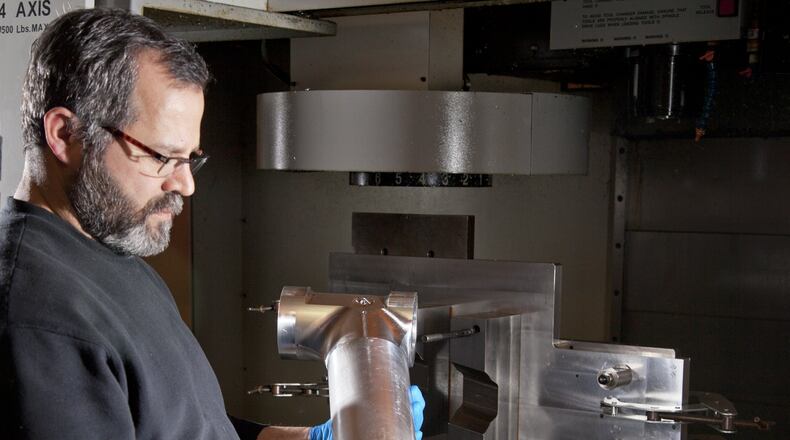Continuing coverage
The looming sequestration deadline of March 1 has many people in the region on edge. The impacts could include the furlough of 13,000 Wright-Patterson Air Force Base employees, cuts to research and other agencies. Our Wright-Patt reporter Barrie Barber, our Washington bureau and others are keeping up with this developing story to bring you the latest news.
Facing higher health care costs and more federal regulations, Rick Little wonders how his Dayton business that has produced parts for fighter jets to submarines will fare if defense spending cuts submerge the bottom line.
Even before automatic defense spending cuts, or sequestration, set to begin March 1, Little said he started to notice a reduction in Starwin Industries sales to the military around August. The company has made aircraft radomes for jets like the F-16 and B-52 to parts for aircraft carrier steam-powered catapults.
“With all the indecision right now, nobody is willing to spend any money,” he said.
Little isn’t alone in his concerns in the Miami Valley.
“Most of the people that are in this business are still trying to wait and see what’s going to happen,” said Michael J. Collinsworth, president of Custom Manufacturing Solutions, Inc. in Xenia. The company of about 35 workers manufactures turret rings for Mine-Resistant Ambush Protected (MRAP) vehicles, among other products and relies on defense spending for about 90 percent of its business. “Obviously, the whole sequestration process is scary for us.”
The Department of Defense budget could absorb $46 billion in sequestration cuts between March and September this year, part of $1 trillion in reductions over a decade to Pentagon spending.
Members of the Joint Chiefs of Staff testified to congressional committees this week the budget reductions would cripple military readiness, force maintenance backlogs that would take years from which to recover, reduce weapons procurement and could furlough up to 800,000 civilian workers at the Department of Defense.
Wright-Patterson Air Force Base has imposed a civilian hiring freeze, and could furlough up to 13,000 workers for 22 days if sequestration happens, among other measures.
Coupled with the threat of the government running out of money March 27 unless Congress agrees to pass a budget or extends a continuing resolution, the situation has caught Robert E. Lord’s attention at Auto-Valve Inc. in Trotwood.
“Quite honestly, I think a double (budget) impact, if they allow them both to occur, would be really severe,” said Lord, the company’s sales and engineering director. “Not really sure how it will impact, but it won’t be good.”
Lord said the Department of Defense wastes “a tremendous amount of money” but the strategy on how to reduce spending, rather than across the board cuts, is crucial.
Along with the swirling uncertainty, he said, his business of about 35 workers has contended with higher price tags for health care and manufacturing materials plus navigating government regulations.
“We’re kind of caught in a little bit of a buzz saw,” he said.
“Essentially, the government through our prime contractors are demanding price reductions,” he added.
Even so, he said, the company has grown at a rate of 20 percent a year, business has jumped in recent weeks and he predicted an ongoing rise in sales because of investments that boosted productivity.
If the cuts occur, he expected the Pentagon could be under stress to “dramatically cut or shut down” major programs.
But the military would have to maintain older aircraft and equipment, which would mean a demand for the fuel and hydraulic lines his firm manufactures, Lord said.
“When it comes to mission-critical stuff, I think they will keep things flying,” he said.
Like other companies, Auto-Valve may hope to sell more in the commercial market to make up for any reduction in defense spending.
One defense contractor has targeted the future to that growing market.
The Ferco Aerospace Group, headquartered in Franklin, has focused more on manufacturing parts for commercial jet engines in reaction to less defense spending, said company chairman Joseph J. Murphy. Around 80 percent of his firm’s products are assembled for the commercial market and 20 percent for the military.
“It’s been very purposeful over the last few years recognizing there would be a drawdown in defense weapon systems not to be wholly dependent on that type of work for the existence of the company,” he said. “The commercial sector is growing by leaps and bounds.”
The company makes parts for General Electric and Pratt & Whitney jet engines.
But sequestration, he warned, could hurt industrial production of crucial products that would take years to recover. When defense cuts in the 1970s forced a stop in the production of the Air Force B-1 Lancer bomber’s jet engines, the aerospace industry needed five years to spool up again when funding was restored in the 1980s, he said.
“It would be double or more that today,” said Murphy, a 42-year aerospace industry veteran. “Nobody in Washington understands that.”
The nation appears headed to a “hollowed-out defense” that happened in the 1970s, he said. “The difference today is the world is a lot uglier than when (Jimmy) Carter was president,” he said.
Little is frustrated with inaction in Washington, D.C., to resolve the budget crisis.
“I don’t know how to fix Washington, but something has to happen,” he said. “I’m at the point where do something, even if it’s wrong. It seems like business people can adapt to a bad climate.”
About the Author
